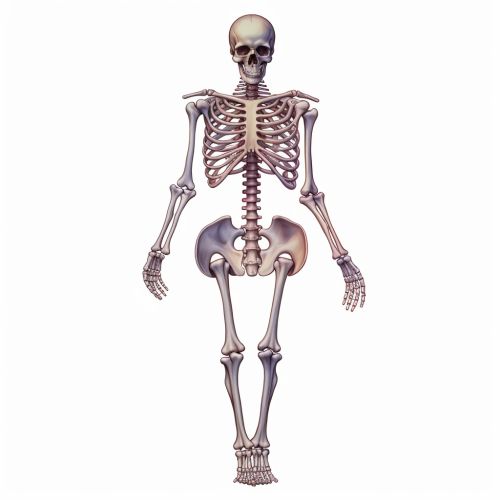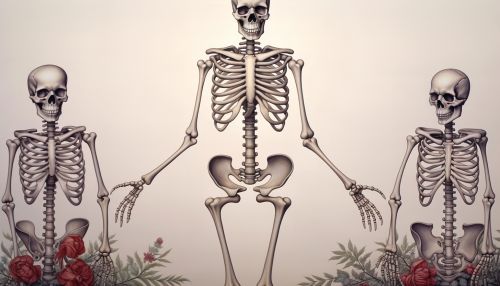Human skeleton
Introduction
The human skeleton is a complex structure composed of 206 bones in adults, providing support, protection, and facilitating movement for the human body. It is a key component of the musculoskeletal system, which also includes muscles, tendons, and ligaments. The human skeleton can be divided into two main components: the axial skeleton and the appendicular skeleton.
Axial Skeleton
The axial skeleton forms the central core of the body and includes the skull, vertebral column, and thoracic cage. It is primarily responsible for protecting the central nervous system and the organs of the thorax.
Skull
The skull is a bony structure that forms the head in vertebrates. It supports the structures of the face and provides a protective cavity for the brain. The skull is composed of two parts: the cranium and the facial bones. The cranium houses and protects the brain, while the facial bones form the framework of the face, contain cavities for the sense organs, and provide openings for air and food passage.
Vertebral Column
The vertebral column, also known as the spine, is a flexible column that extends from the base of the skull to the pelvis. It is composed of a series of bones called vertebrae, which are separated by intervertebral discs. The vertebral column serves to protect the spinal cord, support the head, and act as an attachment point for ribs and muscles.
Thoracic Cage
The thoracic cage, also known as the rib cage, is the skeleton of the chest, consisting of the ribs, sternum, and thoracic vertebrae. It protects vital organs such as the heart and lungs, and provides support for the shoulder girdle and upper limbs.
Appendicular Skeleton
The appendicular skeleton includes the bones of the limbs and the girdles that attach them to the axial skeleton. It is primarily responsible for facilitating movement.
Upper Limbs
The upper limbs, or arms, consist of the humerus in the upper arm, the radius and ulna in the forearm, and the bones of the hand. The hand includes the carpal bones in the wrist, the metacarpal bones in the palm, and the phalanges in the fingers.
Lower Limbs
The lower limbs, or legs, consist of the femur in the thigh, the tibia and fibula in the lower leg, and the bones of the foot. The foot includes the tarsal bones in the ankle, the metatarsal bones in the foot, and the phalanges in the toes.
Girdles
The girdles are the structures that connect the limbs to the axial skeleton. The pectoral girdle, or shoulder girdle, connects the upper limbs to the body, while the pelvic girdle, or hip girdle, connects the lower limbs.
Bone Structure and Composition
Bones are dynamic structures that are constantly being remodeled. They are composed of a combination of collagen, a protein that provides a soft framework, and hydroxyapatite, a form of calcium phosphate that adds strength and hardens the framework. This combination of collagen and hydroxyapatite makes bone both strong and flexible.
Bone Marrow
Bone marrow is a soft, spongy tissue found in the hollow interior of bones. It produces blood cells through a process called hematopoiesis. There are two types of bone marrow: red marrow, which produces red blood cells, white blood cells, and platelets; and yellow marrow, which stores fat.
Bone Development and Growth
Bone development, or ossification, begins in the embryo and continues into adulthood. There are two types of ossification: intramembranous ossification, where bone develops from fibrous tissue, and endochondral ossification, where bone develops from cartilage. Bone growth occurs at the epiphyseal plates, or growth plates, located at the ends of long bones.
Bone Diseases and Disorders
There are many diseases and disorders that can affect the human skeleton, including osteoporosis, arthritis, and fractures. Osteoporosis is a condition characterized by a decrease in bone density, which can lead to an increased risk of fracture. Arthritis is a group of diseases that cause inflammation of the joints, leading to pain and stiffness. Fractures are breaks in the bone, often caused by trauma.
Conclusion
The human skeleton is a remarkable structure that provides support, protection, and movement for the body. It is a dynamic system that is constantly changing and adapting to the demands placed upon it. Understanding the structure and function of the skeleton is essential for understanding human anatomy and physiology.
See Also


